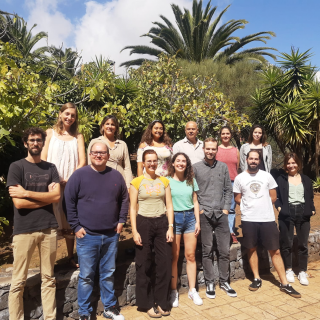Bibcode
Vazdekis, A.; Ricciardelli, E.; Cenarro, A. J.; Rivero-González, J. G.; Díaz-García, L. A.; Falcón-Barroso, J.
Referencia bibliográfica
Monthly Notices of the Royal Astronomical Society, Volume 424, Issue 1, pp. 157-171.
Fecha de publicación:
7
2012
Número de citas
280
Número de citas referidas
265
Descripción
We extend the spectral range of our stellar population synthesis models
based on the MILES and CaT empirical stellar spectral libraries. For
this purpose, we combine these two libraries with the Indo-U.S. to
construct composite stellar spectra to feed our models. The spectral
energy distributions (SEDs) computed with these models and the
originally published models are combined to construct composite SEDs for
single-age, single-metallicity stellar populations (SSPs) covering the
range λλ3465-9469 Å at moderately high and uniform
resolution (full width at half-maximum = 2.51 Å). The colours
derived from these SSP SEDs provide good fits to Galactic globular
cluster data. We find that the colours involving redder filters are very
sensitive to the initial mass function (IMF), as well as a number of
features and molecular bands throughout the spectra. To illustrate the
potential use of these models, we focus on the Na I doublet at 8200
Å and with the aid of the newly synthesized SSP model SEDs, we
define a new IMF-sensitive index that is based on this feature, which
overcomes various limitations from previous index definitions for
low-velocity dispersion stellar systems. We propose an index-index
diagram based on this feature and the neighbouring Ca II triplet at 8600
Å, to constrain the IMF if the age and [Na/Fe] abundance are
known. Finally we also show a survey-oriented spectrophotometric
application which evidences the accurate flux calibration of these
models for carrying out reliable spectral fitting techniques. These
models are available through our user-friendly website.
Proyectos relacionados

Huellas de la Formación de las Galaxias: Poblaciones estelares, Dinámica y Morfología
Bienvenida a la página web del g rupo de investigación Traces of Galaxy Formation. Somos un grupo de investigación amplio, diverso y muy activo cuyo objetivo principal es entender la formación de galaxias en el Universo de una manera lo más completa posible. Con el estudio detellado de las poblaciones estelares como bandera, estamos constantemente
Anna
Ferré Mateu